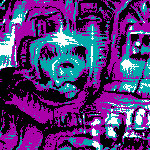|
DeciusMagnus posted:Speaking of Linux compatibility, I use Linux Firefox and the Flash 7 plug-in for Linux in an attempt to make Youtube work. I can see the video but the sound gets out of sync. Has anyone else had this problem? Has anyone been able to fix this? I tried using version 9 of Flash but it just crashes on Youtube. Just install native Firefox and www/swfdec-plugin if you want youtube. It's not perfect and doesn't work for everything (yet!), but youtube plays perfectly and the sound stays in sync unlike with Adobe's binary.
|
|
|
|

|
| # ? Apr 25, 2024 20:10 |
|
Does anyone have FreeBSD running on a Thinkpad (t42)? I'm trying to get the blue mouse button to work, but it doesn't seem to register. I've tried pointing X at /dev/pcm0 and using moused/sysmouse. pcm0 doesn't register any data from the button and moused disables all three buttons on the row. Using moused in debug mode doesn't show any events when the blue mouse button is clicked, but the other buttons seem to work. Does anyone else have this working?
|
|
|
|
I'm new to *nix and trying to install a driver for my 9600 GT on freeBSD 7. It usually ends in breaking Xorg. The last thing I tried was downloading the latest driver from the nvidia site (which is newer than the one that comes automatically from ports), installing it, and at the end it says to run "nvidia-xconfig", I run this from inside gnome and it gives an error, cant find the file, then it writes a new configuration file for X. If I turn off the computer now, X won't start when I turn it back on. I assume I'm supposed to be exiting X and gnome before I run nvidia-config? But I havent found a way to completely exit gnome. Before all that I tried installing the driver from ports and it ended similarly. Once I break X I just reinstall freebsd because I figure it's probably easier than learning to reinstall and configure Xorg. So my main question is, how do I kill Gnome completely once I start running it? "gnome-session-save --kill", I think it was, I was able to log out with, but then it just restarted. Also any help on getting this driver installed in general appreciated, I have almost no idea what I'm doing.
|
|
|
|
Ninja Rope posted:Does anyone have FreeBSD running on a Thinkpad (t42)? I'm trying to get the blue mouse button to work, but it doesn't seem to register. I've tried pointing X at /dev/pcm0 and using moused/sysmouse. pcm0 doesn't register any data from the button and moused disables all three buttons on the row. Using moused in debug mode doesn't show any events when the blue mouse button is clicked, but the other buttons seem to work. Does anyone else have this working? According to http://www.cs.ucr.edu/~trep/tsrT40freebsd.html you should try disabling the touchpad in the BIOS. 
|
|
|
|
Any ideas on how long before ZFS on FreeBSD is going to be considered stable? I'm interested in turning it on and using it on a FreeBSD NAS I have here at work... Non critical data, but would be nice to have it not disappear.
|
|
|
|
helixxo posted:I'm new to *nix and trying to install a driver for my 9600 GT on freeBSD 7. The newest nvidia driver in Ports as of today (173.14.09) supports your card. After you install the driver from Ports (I don't know about doing it manually), don't forget to stick nvidia_load="YES" in /boot/loader.conf, along with linux_enable="YES" if you enabled the driver's Linux compatibility (feel free to disable this with make config if you don't plan on running any OpenGL Linux binaries) It sounds like you're running GDM if x "just keeps restarting" after you kill it. You can get to a login prompt by pressing Ctrl-Alt-[F1-F8]. Ctrl-Alt-F9 will bring you back to X, and Ctrl-Alt-Backspace will kill X if you ever need to. nvidia-xconfig is a console program, and all it really does is replace Driver "nv" with Driver "nvidia" in your /etc/X11/xorg.conf There is also the very nice graphical configuration manager you can install from /x11/nvidia-settings I had to go back to the last 169.xx version of the driver recently since 173 broke OpenGL for me for some reason. Fullscreen GL applications were ok, but anything run in a window would just kill X. Google says it's not just me, at least, so hopefully it will get fixed.
|
|
|
|
Alright, installed the nvidia driver from ports again. I'm not sure exactly when is the best time to put nvidia_load="YES" in /boot/loader.conf but I put it in. nvidia-settings says I need to run nvidia-xconfig first. When I run nvidia-xconfig it just puts a blank file in etc/X11/xorg.conf. So if I try to run X at this point it says: "Failed to initialize nvidia module: please ensure supported nvidia GPU in the system blah blah screens found but none have useable config fatal server error: no screens found" The same thing happens when I try to configure X from the handbook http://www.freebsd.org/doc/en/books/handbook/x-config.html , I'm just making a blank file that gives the same nvidia crash error. I'm guessing the xorg.conf file needs some dang information in it about my monitor and the driver and such. I thought nvidia-xconfig was supposed to edit all that into the file. At least I figured out that I can get X back without reinstalling bsd by just deleting that .conf file :p
|
|
|
|
feld posted:Any ideas on how long before ZFS on FreeBSD is going to be considered stable? I'm interested in turning it on and using it on a FreeBSD NAS I have here at work... Non critical data, but would be nice to have it not disappear. ZFS is a scary blackbox of a beast. My understanding is it's not that it's unstable, you're just on your own for tuning (i.e. nothing in the kernel or userland is going to prevent your data from getting hosed). If that's what you mean by stable, probably not until 8-RELEASE. helixxo posted:I'm guessing the xorg.conf file needs some dang information in it about my monitor and the driver and such. I thought nvidia-xconfig was supposed to edit all that into the file. Wait, are you hitting the "Write to xorg.conf" or whatever the gently caress the button is in the bottom right? If not, you're just changing the run-time configuration.
|
|
|
|
CrzyDTpBoy posted:Wait, are you hitting the "Write to xorg.conf" or whatever the gently caress the button is in the bottom right? If not, you're just changing the run-time configuration.
|
|
|
|
helixxo posted:What button where? I run nvidia-xconfig from command line and it creates a a blank xorg.conf. ...from the terminal? nvidia-xconfig a GUI configuration panel like the ones in Windows. Run it with sudo*, do your configuration, then click "Write to /etc/xorg.conf". *The problems you had in Gnome could actually be caused by not running it as root - I think it tries to write to ~ or something and X isn't looking there for the config file unless you tell it to.
|
|
|
|
CrzyDTpBoy posted:...from the terminal? nvidia-xconfig a GUI configuration panel like the ones in Windows. Run it with sudo*, do your configuration, then click "Write to /etc/xorg.conf". When I try it from a terminal in gnome by entering "su" and then "nvidia-xconfig" it says "garth# nvidia-xconfig WARNING: Unable to locate/open X configuration file. ps: Process environment requires procfs(5) New X configuration file written to '/etc/X11/xorg.conf'"
|
|
|
|
That one message talks about procfs. I think you might need linprocfs mounted for that to work.
|
|
|
|
helixxo posted:I'm not in X when I do it and root is the only login while I'm setting it up. Here we go - procfs(5) error. Do you have the linux compatibility packages installed (pkg_info | grep -i linux)? If not, cd /usr/ports/emulators/linux_base-fc6/ && make install clean. If you do, did you put the right entries: in /etc/fstab: code:code:
|
|
|
|
JHVH-1 posted:That one message talks about procfs. I think you might need linprocfs mounted for that to work. By the way I didn't set up the system with linux compatibility dealy (and I didn't select the linux compatibility option for the driver either), dunno if that might make a difference. edit: ah. alright i'll try that CrzyD
|
|
|
|
I seem to be having trouble with a NFS mount between my FreeBSD server and my Ubuntu laptop. My entry in /etc/exports on FreeBSD is: code:My Ubuntu laptop gets the following command: code:I missed something stupidly easy here, didn't I? This is my first attempt at trying NFS.
|
|
|
|
How exactly is /etc/fstab supposed to look? https://wi.somethingawful.com/9d/9d3fc6fa46261c09abf1d84a472d422f2cebc5e3.png edit: I dunno if the spacing makes a difference but I restored the fstab file and did this: echo "linproc /compat/linux/proc linprocfs rw 0 0" >> /etc/fstab mount -t linprocfs linproc /compat/linux/proc echo "linsys /compat/linux/sys linsysfs rw 0 0" >> /etc/fstab mount -t linsysfs linsys /compat/linux/sys still getting same result from nvidia-xconfig helixxo fucked around with this message at 04:45 on Aug 5, 2008 |
|
|
|
helixxo posted:Xorg, procfs stuff There are two procfs entries you can mount, one for the Linux emulation environment that you already found (Again, not necessary), and one at /proc. HAL requires this to automatically mount things, so you'll want it if you're running GNOME: my fstab posted:proc /proc procfs rw 0 0 And oh, you don't even have an xorg.conf and are just letting X autodetect everything when it starts. I guess that says a lot for how far xorg has come, but run "Xorg -configure" on the console as root and it will make one for you. Then you can run nvidia-xconfig on it. Don't forget the capital X.
|
|
|
|
jnr posted:There are two procfs entries you can mount, one for the Linux emulation environment that you already found (Again, not necessary), and one at /proc. HAL requires this to automatically mount things, so you'll want it if you're running GNOME: jnr posted:And oh, you don't even have an xorg.conf and are just letting X autodetect everything when it starts. I guess that says a lot for how far xorg has come, but run "Xorg -configure" on the console as root and it will make one for you. Then you can run nvidia-xconfig on it. Don't forget the capital X. edit: I went ahead and put the xorg.conf file that "Xorg -configure" creates in /etc/X11 and ran nvidia-xconfig. When I try startx the screen goes black with a static grey cursor block in the top left and wont respond. This is the xorg.conf file http://senduit.com/d8ae2a One thing I notice is not much info under monitor. edit: geeze. So I tried filling in the x configuration sample of: HorizSync 30-107 VertRefresh 48-120 for the monitor and: Section "Screen" Identifier "Screen0" Device "Card0" Monitor "Monitor0" DefaultDepth 32 SubSection "Display" Viewport 0 0 Depth 32 Modes "1400x900" EndSubSection for the screen. Ran startx and it said 32 was too high for the card so I tried the x configuration sample of: Section "Screen" Identifier "Screen0" Device "Card0" Monitor "Monitor0" DefaultDepth 24 SubSection "Display" Viewport 0 0 Depth 24 Modes "1024x768" EndSubSection Ran startx and it said making an authentication how it usually starts, then froze with the text on the screen. I rebooted and now the file system seems to be trashed, stuff is read wrong and boot fails and asks me where the shell is. (so, gonna reinstall) helixxo fucked around with this message at 06:12 on Aug 5, 2008 |
|
|
|
Sergeant Hobo posted:I seem to be having trouble with a NFS mount between my FreeBSD server and my Ubuntu laptop. A couple of NFS notes: 1) Your user UID and GID should be the same on both machines. Run "id" as you on both machines and make sure the UID and GID on each are the same. If they're not, NFS will think you are someone you're not, and this can cause permission errors. There are a few ways to work around this, if this is the cause of the problem. 2) For security reasons, the root account is treated specially over NFS and is mapped (usually) to "nobody", or another service account, which usually has read-only access across the filesystem. If you're logged in as root on the Ubuntu machine, this could be part of the problem. Try not to use root over NFS, but if you must, you can use the maproot command in exports to tell the server that when a client tries to access a file as root, it should treat that as if a different local user were accessing the file. You can use -maproot=root to disable this feature.
|
|
|
|
helixxo posted:I don't know what you mean. Are you saying to do for "proc" what I did for "linproc" an "linsys"? Yep. You don't even really need linproc, linsys, or the linux environment enabled at all unless you plan on running Linux binaries. If everything you're going to install is in Ports (and doesn't have "linux-" in the name) you can disable it after reconfiguring your nvidia driver not to use it (with "make config deinstall clean install" in that directory). quote:xorg Check your /var/log/Xorg.0.log to see when/why it's dying. If you get the prompt saying "run fsck manually" that asks which shell to use just hit Enter to select /bin/sh, run "fsck -y", and then "exit" once it's done to complete the boot like normal. If you plan on running compiz or anything like that tack this on to the bottom of your xorg.conf: code:
|
|
|
|
another generic recommended/best practices FreeBSD installation question. After I get 7.0-RELEASE loaded via CD, what's the best option to do afterwards? Update the ports tree or update my system to 7.0-STABLE or does it really even matter? atticus fucked around with this message at 07:19 on Aug 5, 2008 |
|
|
|
complex posted:According to http://www.cs.ucr.edu/~trep/tsrT40freebsd.html you should try disabling the touchpad in the BIOS. Thanks! I tried this and it does actually work, but it also disables the touchpad.  I seem to remember being able to get both the touchpad and the nipple mouse working at the same time in windows, yes?
|
|
|
|
atticus posted:another generic recommended/best practices FreeBSD installation question. There's no real need to follow STABLE unless you want some cutting-edge feature for the base system, just stick with the latest errata release and get the newest port tree. uncleTomOfFinland fucked around with this message at 08:57 on Aug 5, 2008 |
|
|
|
Ninja Rope posted:A couple of NFS notes: 1) It would appear that the UID and GID on my FreeBSD machine is 1003 whereas it's 1000 on my Ubuntu laptop. So that appears to be a start to fixing the problem. But I'm not entirely sure on how to change those values. Off to  I suppose. I suppose.2) Would invoking the mount via sudo cause a problem like this? Believe me, I don't want to use the root user over NFS if I don't have to. I'll look into the maproot exports option just in case though. Thanks.
|
|
|
|
Sergeant Hobo posted:1) It would appear that the UID and GID on my FreeBSD machine is 1003 whereas it's 1000 on my Ubuntu laptop. So that appears to be a start to fixing the problem. But I'm not entirely sure on how to change those values. Off to Changing UIDs and GIDs is kind of complicated, but is the best method I know of for resolving this problem. If someone has a better one, do tell. You can use the "id" command followed by a number to find out which UIDs are in use and which are not. Check and see if UID 1000 is free on your BSD server or if 1003 is free on your linux machine. If it's free on the linux machine, change it there. Otherwise change it on the BSD machine. If both are free, change it on the box with the least files/stuff running on it. To change a UID on freebsd you should log in in single user mode and run "chpass <user>". You get a little editor/UI where you can change the UID and save. Once that's done, you have to "chown -R <user> ~/<user>" so the user can access all of their files. Once complete, you can reboot and log in as that user. Usually. Pavol Paska posted:There's no real need to follow STABLE unless you want some cutting-edge feature for the base system, just stick with the latest errata release and get the newest port tree. CURRENT contains all of the newest features, STABLE contains bug and security fixes, but also new features as once they are considered stable. You can also track the stable branch for your release, eg, RELENG_7_0, for just critical fixes and no new features. I generally rebuild world+kernel on a new box, to get it up to STABLE and then leave it alone until I have a reason to upgrade it again (eg, affected by a security issue, need a new feature, etc). I don't see any significant changes to STABLE from RELEASE for 7.0.
|
|
|
|
So from the sound of it, it can be a fairly big, complicated problem to keep all these UIDs in sync if you're running multiple *NIX machines.Ninja Rope posted:
Both are free so I'm going to change the Linux machine around. Hopefully this fixes the problem. EDIT: Somehow, I get the feeling that if both machines were Linux or both were FreeBSD, this wouldn't have come up, right? Sergeant Hobo fucked around with this message at 01:34 on Aug 6, 2008 |
|
|
|
It's a non-issue if you know about it ahead of time, since you can specify the UID when you create the user, you probably just never noticed the option. Most companies have a master passwd file with all users and their unique UIDs, and each machine that is rolled out just pulls from that file. If you had installed the same OS on both machines, it is likely they would have picked the same UID, but not guaranteed. By default, UIDs are allocated in order, and some packages (apache, bind, etc) will add users on their own. Generally, users added by packages get UIDs of < 1000, but it's hard to predict which UIDs will be allocated by users created by default by the OS, by packages installed, or by the user herself. If the GIDs are incorrect you may need to do similar for the GIDs, but I don't know of any way of changing the GID of a group other than by editing /etc/groups. However, you can set the UID and GID at the same time when you do "chmod -R user:usersgroup ~user" at the end to save time. You can probably get by by not changing the GIDs to match, but it may be helpful to change them for simplicity. Keep in mind that if your user is not in the Wheel group on BSD, he will not be able to run "su". Make sure there are no user processes running when you change the UIDs or things will get very confused very fast. Good luck!
|
|
|
|
So for anyone wondering, typing kldload ipfw over an ssh connection is not a good plan. Even less so if you don't have the hosting account information. That was a fun hour. "No guys, really, the SERVER IS DOWN. It is TWO AM. The owner is not awake and his phone is off! JUST REBOOT IT YOU CAN'T PING IT LOOK" That said, I'd like suggestions as to what the easiest firewall is to set up on freebsd. I'm leaning toward ipfw because I'm an OSX guy and therefore learning it will be useful for both OSes.
|
|
|
|
Ryouga Inverse posted:So for anyone wondering, typing kldload ipfw over an ssh connection is not a good plan. Enable a fully open (ie: as if it wasn't turned on) firewall using ipfw: add to rc.conf: firewall_enable="YES" firewall_type="open" And the rc files will do everything else (load ipfw module, etc). Then just look at the rc.firewall[6] files and check out the example rules in there.
|
|
|
|
unknown posted:Enable a fully open (ie: as if it wasn't turned on) firewall using ipfw: Yeah, I got that from the documentation that I should have read before typing commands blindly from IRC. I suppose that's sort of my own fault, as though anyone ever makes a serious suggestion on irc  Assuming I'm not using the machine as a router, but I do at some point possibly want to set up jails, is there any difference between ipfw and pf?
|
|
|
|
I think pf is a lot easier to configure. It also has several powerful options missing from ipfw, and pf is considered "the future". As far as I know, the only feature available in ipfw that is not in pf is divert sockets, where as pf adds built in bandwidth throttling, built in NAT, the "scrub" command, etc. Either would work fine, but I would start with pf if I were you.
|
|
|
|
Ninja Rope posted:I think pf is a lot easier to configure. It also has several powerful options missing from ipfw, and pf is considered "the future". As far as I know, the only feature available in ipfw that is not in pf is divert sockets, where as pf adds built in bandwidth throttling, built in NAT, the "scrub" command, etc. I don't know if anyone has called pf 'the future', since nat/bandwidth throttling is fully available in ipfw. But basically it can be summed up as: pf - built by openbsd group ipfw - built by freebsd group ipf - built as an OS independent system. With pf and ipfw being the main two for Freebsd with basically the same feature set. IIRC, the main difference was licensing of the code. Anyways, you can check out the details in the handbook: http://www.freebsd.org/doc/en_US.ISO8859-1/books/handbook/firewalls.html
|
|
|
|
I always had efficiency problems with usb mass storage devices under freebsd. They seem to be extremely slow. In particular when using msdosfs(5). I remember seeing some notice about some Google Summer of Code project that would improve it (especially make it support Isochronous usb transfers). How is the support now in CURRENT?
|
|
|
|
I finally got around to changing my user's ID on my laptop and now my NFS mount works perfectly. Thanks to everyone who helped.
|
|
|
|
I much prefer pf over ipfw. I don't do anything too special with my firewalling or demand too much of it, but I much prefer the way pf has a parsed configuration file rather than just a script of "ipfw" commands. I've found my firewall stuff much easier to maintain and a lot less scary to reload with pf. Plus, there's pftop and pflog, which are both awesome.
|
|
|
|
freebsd.kde.org posted:Recent Updates Compiling now... on a P4 (10 hours so far) no errors unless you don't reinstall glib 2.16.5 instead of 2.14.x
|
|
|
|
Big updates like that scare me. I usually take a few weeks vacation from portsnap'ing. But that is just because I'm a big wuss. Kudos to the KDE on FreeBSD team.
|
|
|
|
complex posted:Big updates like that scare me. I usually take a few weeks vacation from portsnap'ing. Well its a P4, so I don't have that much going on with it. But so far its been smooth sailing.And I can give bug reports if it cocks up since I am really looking forward to 4.1 and its candy coated goodness.
|
|
|
|
complex posted:Big updates like that scare me. I usually take a few weeks vacation from portsnap'ing. I thought portsnap just grabbed the latest update to the ports tree, but didn't actually perform any software updates?
|
|
|
|

|
| # ? Apr 25, 2024 20:10 |
|
atticus posted:I thought portsnap just grabbed the latest update to the ports tree, but didn't actually perform any software updates? Yes, this is true. But I have OCD, so I can't have any updates pulled but not applied. If "portversion -v" shows any updates are needed I don't sleep well.
|
|
|

















